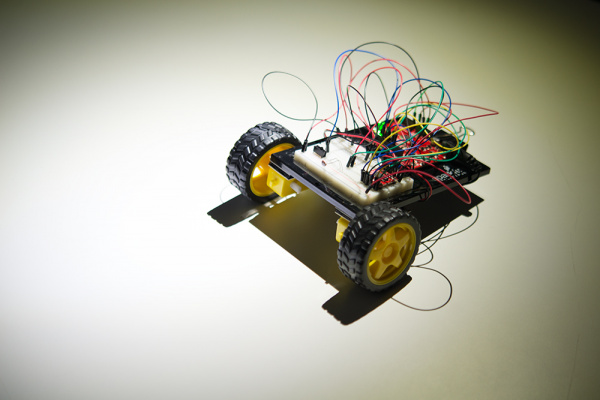Light-Seeking Robot
Programming
Note: This example assumes you are using the latest version of the Arduino IDE on your desktop. If this is your first time using Arduino, please review our tutorial on installing the Arduino IDE.
Copy and paste the following code in the Arduino IDE. Click Upload and see what happens!
language:c
/**
* Light Seeking Robot
* Date: November 9, 2017
* Author: Shawn Hymel (SparkFun Electronics)
*
* 2-wheeled robot moves toward the brightest light by first
* checking left, right, and center.
*
* Parts for this project can be found in the SparkFun
* Inventor's Kit v4.0: https://www.sparkfun.com/products/14265
*
* This sketch was written by SparkFun Electronics, with lots of
* help from the Arduino community. This code is completely free
* for any use.
*/
// Pins
const int PWMB = 8;
const int BIN2 = 9;
const int BIN1 = 10;
const int AIN1 = 11;
const int AIN2 = 12;
const int PWMA = 13;
const int SW_PIN = 7; // Switch to turn the motors on and off
const int LIGHT_PIN = A0; // Photocell
// Constants
const int SEARCH_DRIVE_TIME = 200; // Time to run one motor while searching
const int TURN_DRIVE_TIME = 200; // Time to turn in a direction
const int MOVE_DRIVE_TIME = 300; // Time to drive in a direction
const int STOP_DRIVE_TIME = 200; // Time to stop after moving
const int NUM_LIGHT_LEVELS = 3;
void setup() {
// Set switch pin
pinMode(SW_PIN, INPUT_PULLUP);
// Set the motor control pins as outputs
pinMode(AIN1, OUTPUT);
pinMode(AIN2, OUTPUT);
pinMode(PWMA, OUTPUT);
pinMode(BIN1, OUTPUT);
pinMode(BIN2, OUTPUT);
pinMode(PWMB, OUTPUT);
// Initialize Serial comms
Serial.begin(9600);
Serial.println("Feed me photons!");
}
void loop() {
// Store light levels as array [left, center, right]
int light_levels[NUM_LIGHT_LEVELS];
// If switch is flipped, search for light
if(digitalRead(SW_PIN) == LOW){
// Record light value to the left
drive(0, 255);
delay(SEARCH_DRIVE_TIME);
drive(0, 0);
delay(STOP_DRIVE_TIME);
light_levels[0] = analogRead(LIGHT_PIN);
drive(0, -255);
delay(SEARCH_DRIVE_TIME);
drive(0, 0);
delay(STOP_DRIVE_TIME);
// Record light value to the right
drive(255, 0);
delay(SEARCH_DRIVE_TIME);
drive(0, 0);
delay(STOP_DRIVE_TIME);
light_levels[2] = analogRead(LIGHT_PIN);
drive(-255, 0);
delay(SEARCH_DRIVE_TIME);
drive(0, 0);
delay(STOP_DRIVE_TIME);
// Record light value in the center
light_levels[1] = analogRead(LIGHT_PIN);
// Find direction of max light
int max_light = 0;
int max_light_index = 0;
for ( int i = 0; i < NUM_LIGHT_LEVELS; i++ ) {
if ( light_levels[i] > max_light ) {
max_light = light_levels[i];
max_light_index = i;
}
Serial.print(light_levels[i]);
Serial.print(" ");
}
Serial.println();
Serial.print("Max light: ");
Serial.println(max_light_index);
// Move in the direction of max light
if ( max_light_index == 0 ) {
Serial.println("Chasing light to the left");
drive(-100, 255);
delay(TURN_DRIVE_TIME);
drive(255, 255);
delay(MOVE_DRIVE_TIME);
drive(0, 0);
delay(STOP_DRIVE_TIME);
} else if ( max_light_index == 1 ) {
Serial.println("Chasing light straight ahead");
drive(255, 255);
delay(MOVE_DRIVE_TIME);
drive(0, 0);
delay(STOP_DRIVE_TIME);
} else {
Serial.println("Chasing light to the right");
drive(255, -100);
delay(TURN_DRIVE_TIME);
drive(255, 255);
delay(MOVE_DRIVE_TIME);
drive(0, 0);
delay(STOP_DRIVE_TIME);
}
// If switch is not flipped, do nothing
} else {
drive(0, 0);
}
}
void rightMotor(int motorSpeed)
{
// If speed is positive, run the motor forward
if (motorSpeed > 0) {
digitalWrite(AIN1, HIGH);
digitalWrite(AIN2, LOW);
// If it's negative, run the motor backward
} else if (motorSpeed < 0) {
digitalWrite(AIN1, LOW);
digitalWrite(AIN2, HIGH);
// If it's 0, brake the motor
} else {
digitalWrite(AIN1, LOW);
digitalWrite(AIN2, LOW);
}
analogWrite(PWMA, abs(motorSpeed));
}
void leftMotor(int motorSpeed)
{
// If speed is positive, run the motor forward
if (motorSpeed > 0) {
digitalWrite(BIN1, HIGH);
digitalWrite(BIN2, LOW);
// If it's negative, run the motor backward
} else if (motorSpeed < 0) {
digitalWrite(BIN1, LOW);
digitalWrite(BIN2, HIGH);
// If it's 0, brake the motor
} else {
digitalWrite(BIN1, LOW);
digitalWrite(BIN2, LOW);
}
analogWrite(PWMB, abs(motorSpeed));
}
void drive(int leftSpeed, int rightSpeed) {
leftMotor(leftSpeed);
rightMotor(rightSpeed);
}
What You Should See
When the switch is OFF, the robot will not move. When you turn the switch ON, the robot will turn left and right, taking light measurements at each extreme. It will also take a light measurement from the center.
The robot turns to the direction with the most light and moves forward a small amount. It then repeats the pattern of looking for light and moves toward the direction of brightest light.
Note that trying to direct the robot with a flashlight or other light source can be difficult. Reflected light from the wheels can sometimes be brighter, for instance, than reflected light on the ground. It can take some patience to get the robot to move the way you want. You can also try modifying the code to make it faster at taking three measurements (by spinning the wheels more quickly or not turning as far to measure) or to take more than three measurements at a time.

